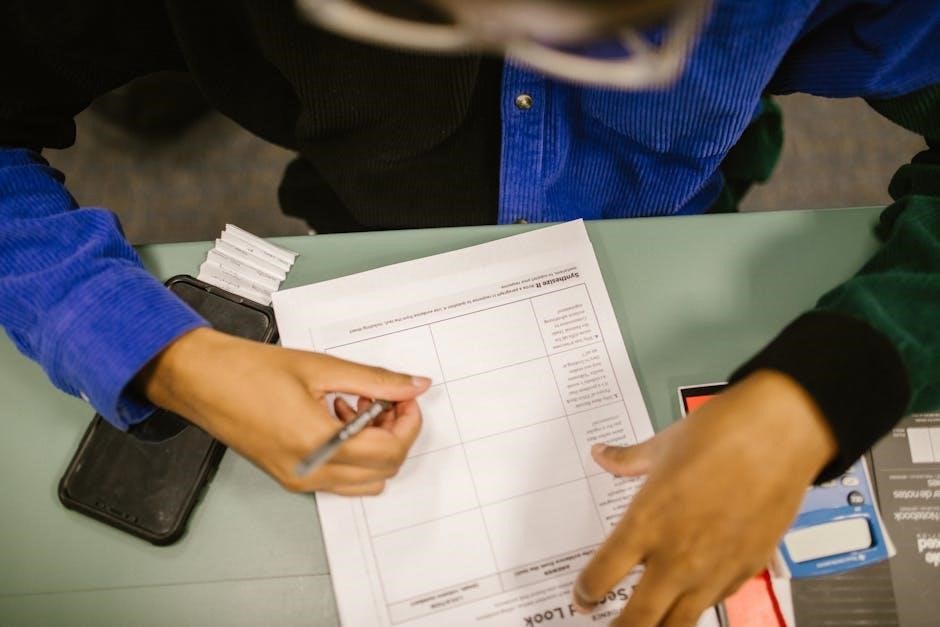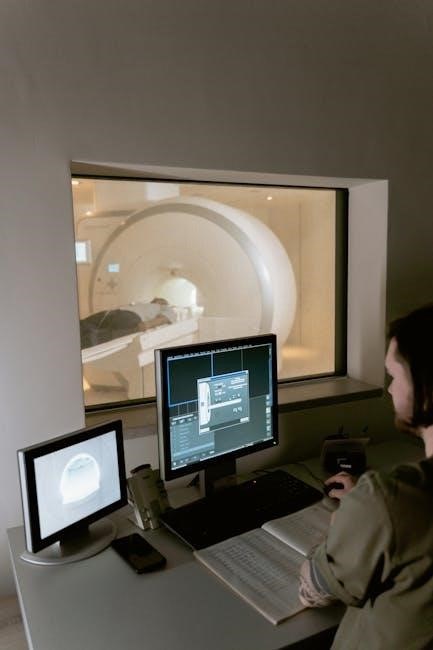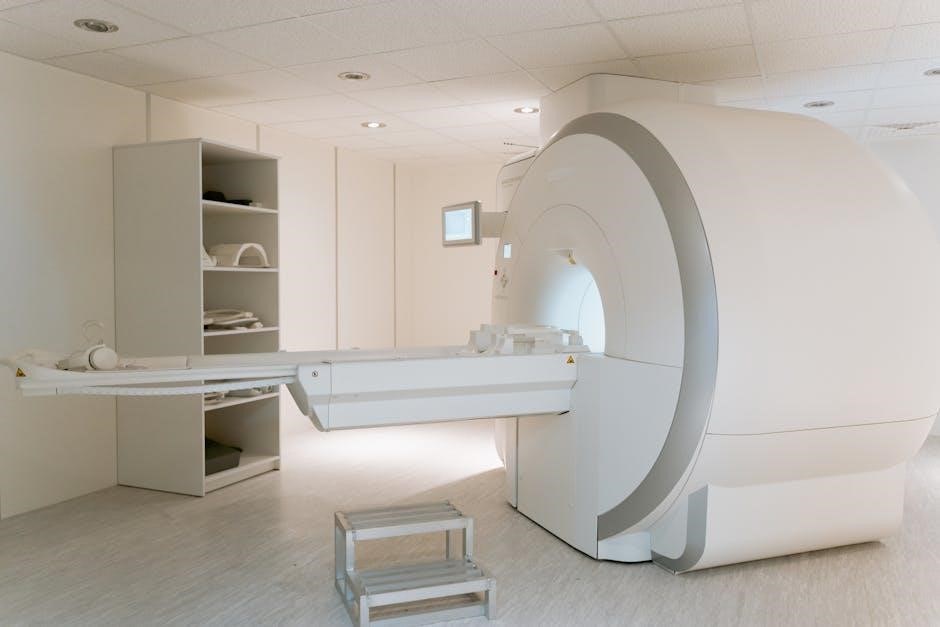The CAFAS (Child and Adolescent Functional Assessment Scale) is a standardized tool assessing behavioral, emotional, and psychological functioning in youth aged 5-19. It evaluates eight psychosocial domains, providing insights for treatment planning and tracking changes over time; Widely recognized as the gold standard, the CAFAS supports clinical decisions and outcome documentation, with a structured PDF format available for easy assessment and reporting.
1.1 What is the CAFAS Assessment?
The CAFAS (Child and Adolescent Functional Assessment Scale) is a standardized tool designed to evaluate the behavioral, emotional, and psychological functioning of children and adolescents aged 5-19. It assesses eight key psychosocial domains, including school, home, and community relationships, to identify functional impairments. The CAFAS provides a comprehensive framework for understanding a youth’s abilities and service needs, aiding in treatment planning, placement decisions, and outcome documentation. Its structured approach ensures consistency, while the PDF format offers accessibility and ease of use for clinicians and professionals working in mental health, education, and juvenile justice settings.
1.2 Purpose and Importance of CAFAS
The primary purpose of the CAFAS assessment is to evaluate the functional needs of children and adolescents across various psychosocial domains, ensuring tailored interventions and support. Its importance lies in providing a standardized method to identify impairments, guide treatment planning, and monitor progress over time. By assessing functioning in key areas like school, home, and community, the CAFAS helps determine appropriate service levels and placements. This tool is essential for clinicians, educators, and caseworkers to make informed decisions, enhance outcomes, and allocate resources effectively, ultimately improving the quality of care for youth in diverse settings.

1.3 Brief History and Development of CAFAS
The CAFAS assessment emerged in the late 20th century as a response to the need for a standardized tool to evaluate youth functioning. Initially developed to address gaps in assessing impairments across psychosocial domains, it gained recognition for its comprehensive approach. Over time, the tool evolved to incorporate feedback from practitioners and research findings, ensuring its relevance and effectiveness. Its development was driven by the goal of providing a reliable method to guide treatment planning and track outcomes. Today, the CAFAS is widely used in clinical, educational, and juvenile justice settings, supported by extensive validation studies.

Key Features and Benefits of CAFAS
The CAFAS assessment offers a standardized, validated approach to evaluating youth functioning. It sensitively tracks changes over time, covering multiple psychosocial domains. Its PDF format enhances accessibility and ease of use in clinical, educational, and justice settings.
2.1 Standardized Approach to Assessment
The CAFAS assessment employs a standardized approach, ensuring consistency and reliability in evaluating youth functioning. Its structured framework includes predefined criteria and scales, enabling assessors to measure psychosocial domains uniformly. This standardization minimizes variability, allowing for accurate comparisons across assessments. The PDF format further enhances this by providing a clear, organized layout that guides assessors systematically. Training ensures inter-rater reliability, while the tool’s validation supports its credibility. This standardized method is particularly valuable for tracking progress over time and facilitating consistent decision-making in treatment planning.
2.2 Validity and Sensitivity in Detecting Change
The CAFAS assessment is renowned for its strong validity and sensitivity in detecting changes in youth functioning. Its evidence-based design ensures accurate measurement of psychosocial domains, while its sensitivity captures subtle improvements or declines over time. The tool’s ability to track longitudinal changes makes it invaluable for monitoring treatment progress. The PDF format preserves this precision, providing a reliable record of assessments. This sensitivity is particularly crucial in clinical settings, where even small changes can inform treatment adjustments and improve outcomes for youth.
2.3 Ease of Use and Time Efficiency
The CAFAS assessment is designed for ease of use, ensuring efficient administration without compromising depth. The structured format and clear guidelines reduce complexity, allowing assessors to focus on capturing accurate information. The PDF version enhances accessibility, enabling easy distribution and completion in various settings. Training emphasizes streamlined processes, minimizing time spent on administration. This efficiency makes the CAFAS practical for busy professionals, ensuring timely assessments while maintaining reliability. The tool’s user-friendly nature supports consistent implementation across diverse environments, from clinical settings to schools, making it a valuable resource for assessing youth functioning.
Structure of the CAFAS Assessment
The CAFAS assessment is organized into a clear, comprehensive framework that evaluates various aspects of youth functioning, ensuring a structured and effective approach to assessment.
3.1 Overview of the Assessment Framework
The CAFAS assessment framework provides a comprehensive and structured approach to evaluating the functioning of youth across multiple domains. It is designed to identify strengths, challenges, and areas requiring intervention, ensuring a holistic understanding of a youth’s needs. The framework incorporates standardized criteria, making it reliable and consistent across assessments. It also allows for the integration of goals and objectives, facilitating individualized treatment planning. By focusing on key psychosocial domains, the CAFAS framework offers a clear and organized method to assess, track, and improve youth outcomes effectively.
3.2 Eight Psychosocial Domains Assessed
The CAFAS assessment evaluates eight critical psychosocial domains that impact youth functioning: Home Situation, School/Work, Community Involvement, Peer Relationships, Family Relationships, Self-Concept, Behavior Toward Others, and Thinking Skills. Each domain assesses specific behaviors and challenges, providing a comprehensive understanding of a youth’s strengths and needs. These domains are interconnected, allowing for a holistic view of functioning across different environments. By focusing on these key areas, the CAFAS ensures a balanced and detailed evaluation, enabling targeted interventions and support strategies.
3.3 Scoring System and Interpretation
The CAFAS uses a standardized scoring system to measure functioning across domains. Scores range from minimal impairment (0) to severe impairment (100+), with higher scores indicating greater need for support. Each domain is scored individually, and overall scores reflect total functioning. Interpretation guides understanding of strengths and challenges, aiding in treatment planning and goal setting. The system ensures consistency in assessing progress over time, helping track improvements or declines in youth functioning. This structured approach allows for clear communication among professionals and informed decision-making for interventions and support strategies.
3.4 Role of Strengths and Goals in Assessment
In the CAFAS assessment, identifying strengths and goals plays a crucial role in fostering a holistic understanding of a youth’s functioning. Strengths are recognized as positive attributes or skills that can aid in treatment and development. Goals are established based on assessment outcomes, providing clear targets for improvement. This dual focus ensures interventions are balanced, addressing challenges while building on existing capabilities. By integrating strengths and goals, the CAFAS supports tailored treatment plans and encourages a proactive approach to enhancing functioning across various domains. This balanced perspective helps guide interventions and track progress effectively over time.

Conducting the CAFAS Assessment
Conducting the CAFAS assessment involves trained assessors following a structured process to evaluate youth functioning. It ensures objective evaluation in a suitable setting with necessary tools for accurate outcomes.
4.1 Administration Process and Requirements
The CAFAS assessment is administered by trained professionals who follow a standardized process. Assessors must complete certification to ensure reliability and accuracy. The assessment typically occurs in a clinical or school setting, requiring access to relevant information about the youth. The process involves reviewing records, observing behavior, and conducting interviews with the youth and caregivers. The use of the CAFAS PDF format ensures consistency and ease of documentation. Assessors must adhere to ethical guidelines and maintain confidentiality throughout the process. Proper preparation and a suitable environment are essential for accurate and valid results.
4.2 Role of the Assessor and Training Needed
The CAFAS assessor plays a critical role in ensuring accurate and reliable results. Assessors must be trained professionals, such as psychologists, social workers, or counselors, with expertise in child and adolescent functioning. Certification is required to administer the CAFAS effectively, involving completion of specialized training programs. These programs cover assessment techniques, scoring guidelines, and interpretation of results. Assessors must also possess strong observational and interviewing skills to gather accurate data. Ongoing professional development is recommended to maintain proficiency and stay updated on best practices. The assessor’s expertise ensures the CAFAS assessment is both valid and meaningful for treatment planning and intervention.
4.3 Data Collection Methods and Sources
The CAFAS assessment relies on multiple data collection methods to ensure comprehensive evaluation. Primary sources include interviews with the youth, caregivers, and key informants such as teachers or healthcare providers. Observational data is also critical, capturing behaviors in various settings. Additionally, review of historical records, like school reports or medical histories, provides context. These diverse sources enhance the accuracy of the assessment, allowing a holistic understanding of the youth’s functioning across different domains. This multi-method approach ensures that the data collected is both reliable and representative of the individual’s needs and strengths.
4.4 Duration and Setting of the Assessment
The CAFAS assessment typically takes 60 to 90 minutes to complete, depending on the complexity of the case. It is commonly conducted in clinical or office settings, where privacy and comfort can be ensured. However, assessments may also occur in schools, homes, or community centers to accommodate the youth’s needs. The setting should be non-distracting to facilitate open communication. The duration may vary based on the individual’s responsiveness and the availability of collateral information. Ensuring a calm and structured environment is crucial for accurate and effective assessment outcomes.

The CAFAS PDF Format
The CAFAS PDF format is a standardized document designed to organize assessment results, offering a clear and structured presentation of findings for easy interpretation and reporting purposes.
5.1 Layout and Content of the CAFAS PDF
The CAFAS PDF is structured to provide a comprehensive overview of assessment results. It includes sections for client demographics, assessment dates, and scores across all eight psychosocial domains. The layout features clear tables, charts, and graphs to visualize data, making it easy to interpret. Detailed summaries highlight strengths, goals, and areas needing intervention. The PDF also includes instructions for completing the assessment and understanding the scoring system, ensuring clarity for both professionals and stakeholders. This organized format facilitates effective communication and streamlined reporting, aiding in treatment planning and progress monitoring for youth and their families.
5.2 Advantages of Using the PDF Version
The CAFAS PDF version offers enhanced accessibility and convenience. It can be easily shared, viewed, and printed across devices without requiring specialized software. The PDF format ensures consistency in layout and content, preserving the structure for professional presentations. Password protection options enhance security, safeguarding sensitive information. Additionally, the PDF is searchable, allowing quick access to specific sections. This format is ideal for archiving and maintaining records, facilitating seamless communication among professionals. Its portability and reliability make it a preferred choice for clinical, educational, and administrative purposes, ensuring efficient use in treatment planning and progress monitoring for youth and families.
5.3 How to Access and Utilize the CAFAS PDF
Accessing the CAFAS PDF typically requires visiting the official CAFAS website or authorized platforms. Users may need to create an account or log in to download the document. Once obtained, the PDF can be stored on local devices or cloud storage for easy access. To utilize it effectively, open the PDF using a compatible reader, navigate via bookmarks, and print sections as needed. The format ensures compatibility across devices, allowing seamless viewing on computers, tablets, or smartphones. Secure sharing options and encryption features protect confidentiality, making it a reliable tool for professionals in clinical and administrative settings.

Applications and Use Cases

The CAFAS assessment is widely applied in clinical settings for treatment planning, educational institutions for identifying student needs, and juvenile justice systems for assessing youth functioning and outcomes.
6.1 Clinical Settings and Treatment Planning
The CAFAS assessment is extensively used in clinical settings to guide treatment planning for youth with mental health or behavioral challenges. It helps identify functional impairments across various domains, enabling clinicians to develop targeted interventions. By assessing areas such as emotional and behavioral functioning, the tool supports the creation of personalized treatment plans. Clinicians can track progress over time, making it an essential resource for ongoing care and evaluation. Its structured approach ensures consistent and reliable data, aiding multidisciplinary teams in delivering evidence-based practices effectively.
6.2 Educational and School-Based Applications
The CAFAS assessment is widely utilized in educational settings to identify and address the needs of students experiencing challenges. Schools use it to assess functional impairments in areas like academic performance, social interactions, and emotional well-being. This tool aids in developing Individualized Education Programs (IEPs) and monitoring progress over time. By identifying specific needs, educators can tailor support services and interventions. The CAFAS also helps in eligibility evaluations for special education services. Its structured framework supports collaboration between educators, mental health professionals, and families to create a supportive learning environment tailored to each student’s requirements, fostering academic and personal growth effectively.
6.3 Juvenile Justice and Child Welfare Systems
The CAFAS assessment plays a crucial role in juvenile justice and child welfare systems by providing a standardized tool to evaluate the functional abilities of youth. It helps identify challenges such as behavioral issues, family dynamics, and social functioning, which are essential for determining appropriate interventions. In juvenile justice settings, CAFAS informs treatment planning and rehabilitation strategies, ensuring that interventions are tailored to the specific needs of each individual. In child welfare contexts, it aids in assessing the severity of neglect or abuse impacts and guides placement decisions. The assessment’s ability to monitor progress over time supports case management and ensures effective support services.

Training and Certification
CAFAS training and certification ensure assessors master the tool, enhancing credibility and reliability in evaluations. Structured programs, including workshops, prepare professionals to accurately assess youth functioning.
7.1 Requirements for CAFAS Assessors
CAFAS assessors must meet specific requirements to ensure competence and reliability. A bachelor’s degree in a relevant field, such as psychology or social work, is typically required. Completion of authorized CAFAS training and certification is mandatory. Assessors must demonstrate mastery of the tool through exams and practical applications. Ongoing professional development is recommended to stay updated on best practices. Experience working with youth and families is highly valued. Adherence to ethical standards and cultural sensitivity are also critical for accurate and fair assessments. These requirements ensure that assessors are well-prepared to effectively use the CAFAS assessment pdf in various settings.

Research and Outcomes
Research underscores the CAFAS assessment PDF as a validated tool for measuring youth functioning. Studies highlight its reliability in tracking progress and informing treatment decisions effectively.
8.1 Evidence Supporting CAFAS Validity
Research consistently supports the validity of the CAFAS assessment PDF as a reliable measure of youth functioning. Studies demonstrate strong inter-rater reliability and internal consistency across diverse clinical and educational settings. The tool’s ability to detect subtle changes in functioning aligns with its sensitivity to treatment outcomes. Validation studies show high correlation with other standardized measures, reinforcing its credibility. Longitudinal data further highlight its effectiveness in tracking progress over time. These findings underscore the CAFAS assessment PDF as a trusted instrument for clinical decision-making and outcomes evaluation in juvenile populations.
8.2 Tracking Changes in Youth Functioning Over Time
The CAFAS assessment PDF is widely recognized for its ability to track longitudinal changes in youth functioning. By administering the tool at multiple time points, clinicians can monitor progress, identify trends, and evaluate the effectiveness of interventions. This longitudinal capability supports informed decision-making and adjusts treatment plans accordingly. The standardized scoring system ensures consistency, allowing for reliable comparisons over time. This feature is particularly valuable in clinical and educational settings, where documenting improvement or identifying areas of concern is essential for supporting youth development and well-being effectively.

Resources and Support
The CAFAS assessment PDF is supported by comprehensive guides, manuals, and online tools. These resources ensure effective use and interpretation of the assessment, aiding professionals in applying it accurately.
9.1 Guides and Manuals for CAFAS Users
CAFAS users benefit from detailed guides and manuals designed to enhance understanding and application of the assessment. These resources include training manuals, user guides, and interpretive handbooks. They provide step-by-step instructions, examples, and case studies to ensure accurate implementation. Manuals also cover scoring, interpretation, and reporting, making them indispensable for professionals. Additionally, they offer practical tips for integrating CAFAS into clinical, educational, and justice settings. These materials are regularly updated to reflect best practices and research advancements, ensuring users remain informed and proficient in utilizing the CAFAS assessment effectively. They are accessible via the official CAFAS website or authorized distributors.
9.2 Online Tools and Platforms for CAFAS
The CAFAS assessment is supported by various online tools and platforms that streamline its administration and interpretation. These platforms offer digital versions of the assessment, enabling efficient data collection and scoring. Many tools provide automated scoring, reducing errors and saving time. Additionally, online platforms often include training modules, video tutorials, and interactive guides to assist users. Some platforms allow for secure data storage and progress tracking over time. These tools are particularly useful for professionals working in clinical, educational, or justice settings, enhancing the practicality and accessibility of the CAFAS assessment. They ensure a seamless experience for both assessors and participants.



